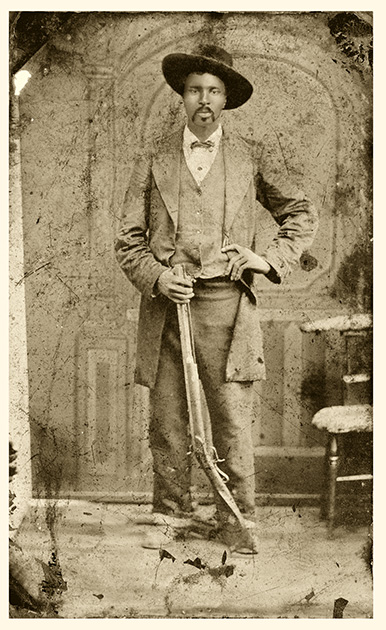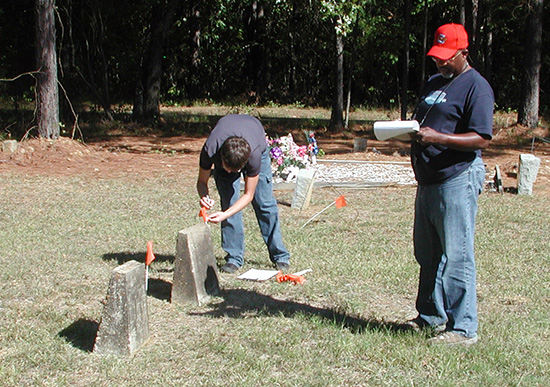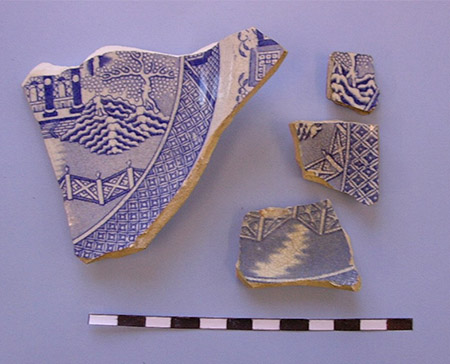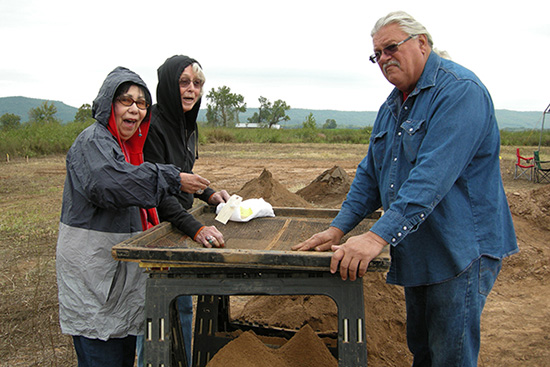Mary Beth Trubitt (Arkansas Archeological Survey, Henderson State University Research Station)

As I write this, Black Lives Matter protests and rallies for racial justice are growing in cities and towns across our country. To me, quietly writing about arrow points seems inadequate, and I ask myself what I can do. I can listen. I can read and learn. I can teach. So, I put together several short essays as “remote archeology lab day” postings to our station’s Facebook page. I wanted to share some thoughts on how archeology can shed light on the past lives of African Americans in Arkansas, because our past impacts us in the present day.
I start with a chapter on the intersection of archeology and public service by my late colleague Jamie Brandon. Brandon (2016) discussed several Arkansas examples that show the importance of making archeological research relevant to people, including descendant communities and the broader public. His archeological project at Van Winkle’s Mill sheds light on the lives of the white owners of the nineteenth-century sawmill as well as the enslaved and free African Americans who worked there before and after the Civil War. Project results have been conveyed to thousands of visitors to Hobbs State Park, and incorporated into fifth-grade curricula on African American heritage in the Arkansas Ozarks for area schoolchildren. Brandon (2013:48) wrote that he tried to reverse the “hillbilly narrative” that “obscures much diversity in the region and, more importantly, absolves the region from its history of racial conflicts.”
Arkansas Archeological Survey archeologists have worked with community groups on several projects to learn more about African American heritage in Arkansas. Take a look, for example, at the cemetery cleaning, mapping, and remote sensing done at the Norwood–Mt. Olive Cemetery by Tim Mulvihill and Jami Lockhart with community members and descendants. I worked with members of the Buffaloes’ Foundation to photograph, document grave markers, and map the Helm Cemetery in Arkadelphia. Jodi Barnes has a multifaceted project to learn about the lives of the people – white and black – who lived and worked at Hollywood Plantation. Her research into the nineteenth-century women who lived at the Brownlee House in Little Rock led to a Preserve Arkansas “Behind the Big House” public program in 2019. Archeology can highlight forgotten pasts that continue to have repercussions for people living here today.

In recent years, archeologists are expanding research on African American heritage from work on eighteenth- and nineteenth-century sites to investigating life in the US in the twentieth century. This work typically involves active collaboration between archaeologists, descendants, and local residents, that is, public archeology or community archeology. Anna Agbe-Davies (2010:173) writes: “Archaeology is valuable to the people I work with not only, or even primarily, because it tells us something new about the past. Rather, archaeology points official attention to silenced stories, it provides necessary analyses of the contemporary environment, it makes connections between the past and the present visible and concrete.”
Some of these projects focus on the variation in lifeways in African American communities and neighborhoods (e.g., Franklin and Lee 2019; Scott 2019) while others explore anti-black racism that displaced communities through racial violence or urban renewal in the twentieth century (e.g., González-Tennant 2018; Mullins 2006). Our colleagues at the Oklahoma Archeological Survey and others are uncovering the history of the Tulsa massacre (see also The Rise, Destruction, and Rebuilding of Tulsa's Greenwood District). Unfortunately, Arkansas has its own twentieth-century history of race massacres.

Edward González-Tennant (2018:1) began his book on the Rosewood (Florida) massacre: “My primary goal in writing is to shed a light on the deep temporal connections between past racial violence and modern social inequality. It can be an uncomfortable course of inquiry, particularly at this moment in time.” Yes, it is uncomfortable, but we need to learn about – and learn from – our history. With the coronavirus pandemic this spring, I kept saying “when things get back to normal.” Now I know we should not go back, we need to move forward, and we all have some work to do.
Over the past weeks, many organizations and corporations have made statements in support of racial justice and the Black Lives Matter movement. For example, the Association of Black Anthropologists issued a statement, and the Southeastern Archaeological Conference recently posted its statement.
Universities – including Henderson State University and the University of Arkansas – are engaged in campus conversations on combating racism and promoting inclusivity. Chancellor Joe Steinmetz encouraged the University of Arkansas community to read posts on the Twitter hashtag #BlackatUARK as a way to listen and learn. More broadly, the Twitter hashtag #BlackInTheIvory has been trending with stories of racism in academia. Listening, reflecting, and learning is a first step.
What actions can we take as a next step? Over 20 years ago, Maria Franklin (1997) asked “Why are there so few black American archaeologists?” She faulted “our attempts as archaeologists to build relationships with the public, especially with descendant communities” (Franklin 1997:800). Since then, the field of public or community archeology has grown, archeological research on the African diaspora has expanded, and the numbers of black archeologists have increased (Lee and Scott 2019). The Society of Black Archaeologists was founded in 2011.

However, there are still disparities in the numbers of people of color employed in our field and in positions of leadership in organizations, universities, and companies. It is still a homogeneous group that publishes in archaeology. In a new study published in American Antiquity, Laura Heath-Stout (2020:2) finds that “despite increasing numbers of women, people of color, and queer people conducting archaeological work, the power to influence archaeological knowledge production continues to be in the hands of the most privileged (male, cisgender, straight, and/or white) researchers.” This is something I have been thinking about as a journal editor. As a professor, I have been thinking about how I teach about race and racism. As a member of organizations – from the Society for American Archaeology to the Arkansas Archeological Society – I have been thinking about how we encourage diversity in our field. We have to start with safe and inclusive field schools. A next step is developing supportive mentoring programs. Arkansas has been a leader in public archeology, historically by including interested community members in the process, and more recently by partnering with descendant groups.
Listening and reading are good first steps, but action is needed for change.
Referenced Cited
Agbe-Davies, Anna S.
2010 Archaeology as a Tool to Illuminate and Support Community Struggles in the Black Metropolis of the Twentieth and Twenty-first Centuries. Public Archaeology 9(4):171-193.
Brandon, Jamie C.
2013 Reversing the Narrative of Hillbilly History: A Case Study Using Archaeology at Van Winkle’s Mill in the Arkansas Ozarks. Historical Archaeology 47(3):36–51.
Brandon, Jamie C.
2016 Regnat Populus: The Intersection of Historical Archeology Research and Public Service in Arkansas. In Research, Preservation, Communication: Honoring Thomas J. Green on His Retirement from the Arkansas Archeological Survey, edited by Mary Beth Trubitt, pp. 174–182. Research Series No. 67. Arkansas Archeological Survey, Fayetteville.
Franklin, Maria
1997 Why Are There So Few Black American Archaeologists? Antiquity 71(274):799-801.
Franklin, Maria, and Nedra Lee
2019 Revitalizing Tradition and Instigating Change: Foodways at the Ransom and Sarah Williams Farmstead, c. 1871-1905. Journal of African Diaspora Archaeology and Heritage 8(3):202-225.
Gonzalez-Tennant, Edward
2018 The Rosewood Massacre: An Archaeology and History of Intersectional Violence. University Press of Florida, Gainesville.
Heath-Stout, Laura E.
2020 Who Writes about Archaeology? An Intersectional Study of Authorship in Archaeological Journals. American Antiquity. DOI: https://doi.org/10.1017/aaq.2020.28.
Lee, Nedra K., and Jannie Nicole Scott
2019 Introduction: New Directions in African Diaspora Archaeology. Transforming Anthropology 27(2):85-90.
Mullins, Paul R.
2006 Racializing the Commonplace Landscape: An Archaeology of Urban Renewal along the Color Line. World Archaeology 38(1):60-71.
Scott, Jannie Nicole
2019 To the City Up North: African American Migration from Antioch Colony to Austin, Texas, 1900-1940. Transforming Anthropology 27(2):105-113.
__________________
Published July 23, 2020
